The Bathers
The Bathers
Oil on canvas, 100 x 160 cm, 1992
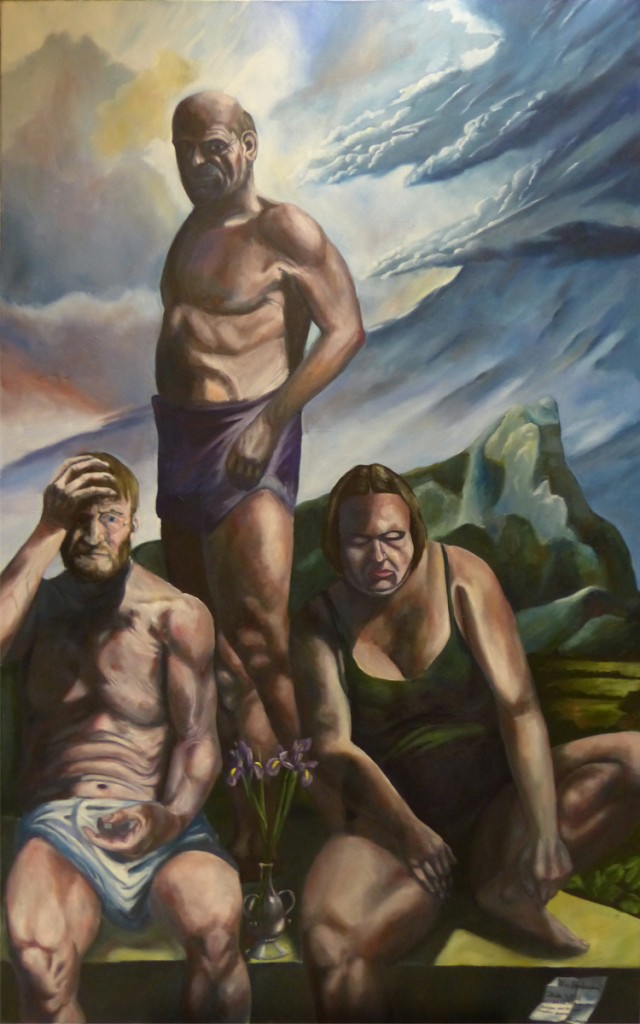
Prolog
The bathers are my first “real” picture. They are the first image that I have thoroughly thought through in terms of topic, colours and composition. In this picture nothing has “accidentally” landed, everything has its meaning. Sometimes even too much of it
I was very young when I painted the picture, just 21. I read a lot at that time especially on art and humanities. So I came across Cezanne and one of his big iconic topics, the bathers. The theme of bathers runs through art history, inspiring artists of all times to paint that Ilysian room with mostly naked people enjoying life and themselves. (Surprisingly, you rarely see sexual connotations, which would be obvious, considering that everyone is naked)
I had just graduated from high school and now had to complete my civil service. I used to have a man with end-stage MS. For me, who had not come into contact with the downsides of life until then, it was not an easy experience. The finitude of life had not yet entered my life. The silk thread on which we all hang was for me a thick indestructible steel rope. This experience led me into a life crisis, and I do not mean the usual lovesickness that is forcibly relived in these hormone-challenged times, but a first real crisis. I sought artistically for this crisis – after all, painting is my means of expression.
At that time I was busy with Cezanne and his leitmotif of bathers. Three years earlier I had seen an exhibition in New York about Cezanne’s early work. Although I was not very impressed, my curiosity was aroused to learn more about the pioneer of modernity and to use it artistically for me. And I was interested in the subject of Arcadian space, which always resonates in this genre. This interest in the “modern Arcadia” manifests itself even today in my “Seaside” pictures
Composition
You can see two men and a woman in front of a landscape. The three are standing or sitting on an indefinite object, maybe a wall. One man is standing, the other man and the woman are sitting in front of him. While the two men look at the spectator, the woman looks down. Between the two seated figures there is a glass vase with an iris. The vase has no water. On the bottom right is a paper with a quote the date and the signature attached.
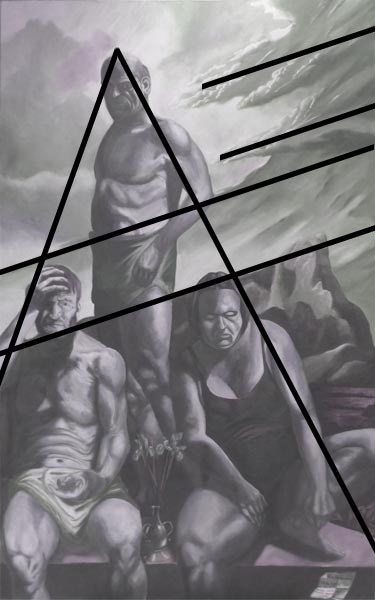
The background is marked by several oblique lines. They begin with the slopy line the mountain marks. The mountain is the Mont St Victoire in Provence, that iconic mountain to which Cezanne repeatedly referred to. The oblique lines continue in the clouds. The middle ground is determined by the landscape that connects the mountain with the group in the foreground.
In the foreground we see a group of people which forms a triangle which points up to the sky giving the composition sort of a metaphysical spin. The triangle , in turn, is pierced by the sloping lines of the mountain and the clouds.
The eye of the beholder is in continous movement. It is led up by the arm of the seated man on the left, to the head of the standing man, then led down again following the arms both of the standing and the seated figure. From there following the legs it returns to the uppointing arm of the left seated figure etc. This round movement is pierced by the sloping lines lines of the mountain and the clouds above . The eye of the beholder is in continous movement. There is no endpoint.
Quotes
The bathers are characterized by a series of picture quotes taken from different periods of art history.
There is, on the one hand, the reference to Cezanne, to the Mont St Victoire in the province. A motive Cezanne painted repeatedly. The version I reffered to is the version that hangs in Philadelphia, but there are more of them. In the Mont ST Victoire series you can see, how Cezanne became what he is known for, as the pioneer of modern art
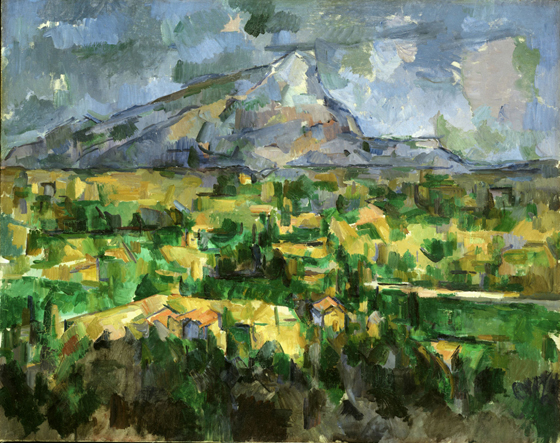
© Paul Cézanne, Mont Sainte-Victoire, 1902-04, oil on canvas, 73 x 91.9 cm ( Philadelphia Museum of Art)
The sky as the element which defines the background adds the belligerent element of the painting is quoted Otto Dix anti-war picture “Flanders”. Otto Dix, as one of my heroes and role model in art, is the anti war artist. Having participated in World War One, he painted various paintings about his experiences in the war. Impressive masterpieces, some of our war driving poiliticians should look at.

© Bildarchiv Preußischer Kulturbesitz / Nationalgalerie, SMB / Jörg P. Anders. Original: Nationalgalerie, Staatliche Museen zu Berlin
The vase and the notice the signature is written upon, is taken from Hans Holbeins Portrait of Georg Giese. Of course I changed the flower, instead of of the flower of the carnation (symbol of promised love) there is an iris (Symbol of creativity).
Holbein has an incredible technique. The way he treats colours, composition and forms is outstanding. Especially considering, that colours based on oil have been invented only a short time ago.
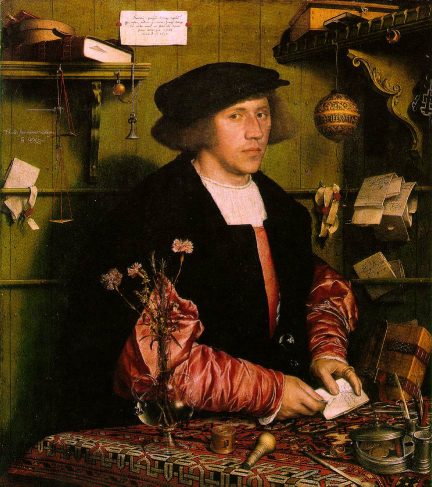
© Bildnis des Danziger Hansekaufmanns Georg Gisze in London (Hans Holbein der Jüngere), Gemäldegalerie, Berlin
The quote on the piece of paper is taken from a poem from Jakob Haringer, called “Schwermut” (Melancholy). Originally it says
“Ich bin ein Fels, der an Veilchen und Moos und Ginster denkt” (I am a rock thinking of violets and moss and broom).
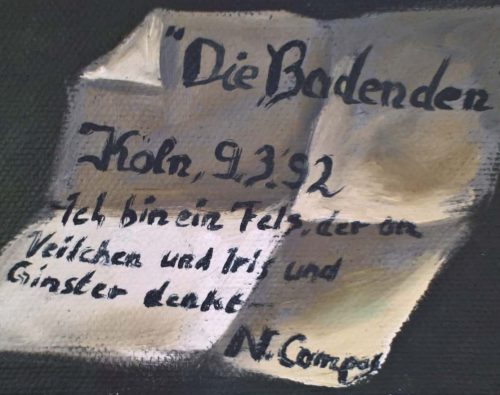
Statement
The bathers are the result of processing a first life crisis. Again and again I have resorted to this form of autotherapy, to banish my internal conflicts on canvas and by doing so processing them.
As claimed before, I was quiet young, when I painted them . I was full of drama and pathos. That’s why the Bathers are filled with drama, too. So I had to turn the Ilysian theme of the bathers in a dramatic mood with cold colours and harsh light / dark contrasts. The way the figures look is vain. Even in the vase there is no water, for the iris to keep alive. Of course the quote on the note is marked by the hopelessness of life.
What a pathos! Come on I was young…
